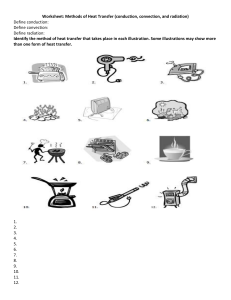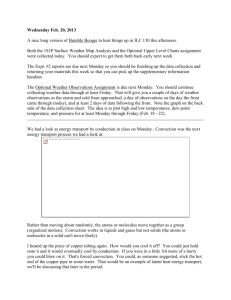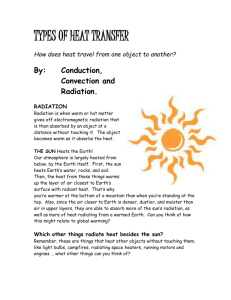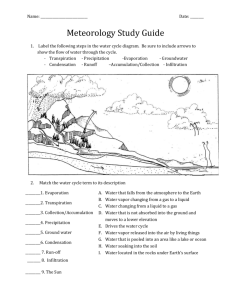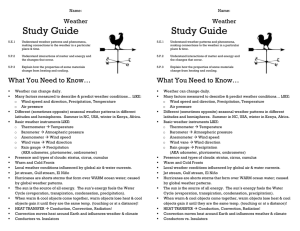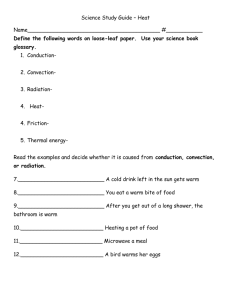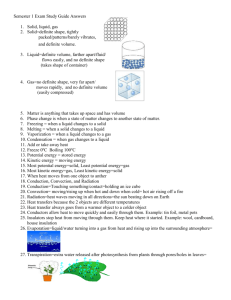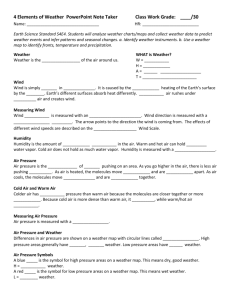oct04
advertisement
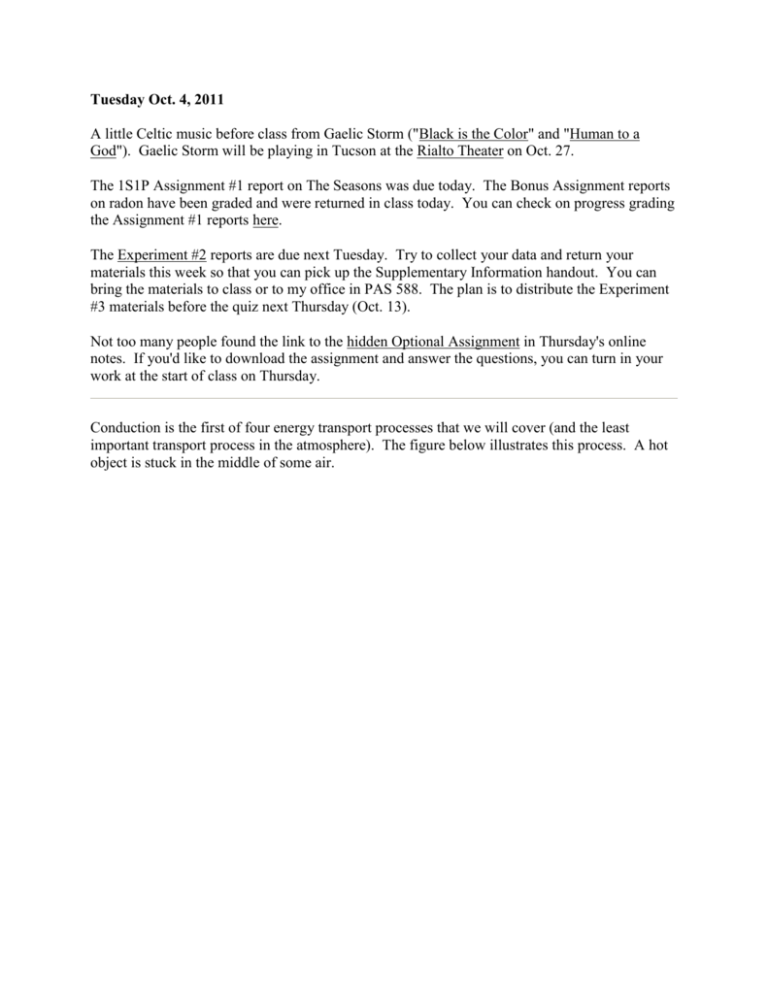
Tuesday Oct. 4, 2011 A little Celtic music before class from Gaelic Storm ("Black is the Color" and "Human to a God"). Gaelic Storm will be playing in Tucson at the Rialto Theater on Oct. 27. The 1S1P Assignment #1 report on The Seasons was due today. The Bonus Assignment reports on radon have been graded and were returned in class today. You can check on progress grading the Assignment #1 reports here. The Experiment #2 reports are due next Tuesday. Try to collect your data and return your materials this week so that you can pick up the Supplementary Information handout. You can bring the materials to class or to my office in PAS 588. The plan is to distribute the Experiment #3 materials before the quiz next Thursday (Oct. 13). Not too many people found the link to the hidden Optional Assignment in Thursday's online notes. If you'd like to download the assignment and answer the questions, you can turn in your work at the start of class on Thursday. Conduction is the first of four energy transport processes that we will cover (and the least important transport process in the atmosphere). The figure below illustrates this process. A hot object is stuck in the middle of some air. In the top picture some of the atoms or molecules near the hot object have collided with the object and picked up energy from the object. This is reflected by the increased speed of motion or increased kinetic energy of these molecules or atoms (these guys are colored orange). In the middle picture the initial bunch of energetic molecules have collided with some of their neighbors and shared energy with them (these are pink). The neighbor molecules have gained energy though they don't have as much energy as the molecules next to the hot object. In the third picture molecules further out (yellow) have now gained some energy. The random motions and collisions between molecules is carrying energy from the hot object out into the colder surrounding air. Conduction transports energy from hot to cold. The rate of energy transport depends first on the temperature gradient of temperature difference. If the object in the picture had been warm rather than hot, less energy would flow or energy would flow at a slower into the surrounding air. The rate of energy transport also depends on the material transporting energy (air in the example above). Thermal conductivities of some common materials are listed. Air is a very poor conductor of energy. I could put my finger alongside the flame from the propane torch and not feel anything. Air is generally regarded as an insulator. Water is a little bit better conductor. Metals are generally very good conductors (cooking pans are often made of stainless steel but have aluminum or copper bottoms to evenly spread out heat when placed on a stove). Diamond has a very high thermal conductivity. Diamonds are sometimes called "ice." They feel cold when you touch them. The cold feeling is due to the fact that they conduct energy very quickly away from your warm fingers when you touch them. Transport of energy by conduction is similar to the transport of a strong smell throughout a classroom by diffusion. Small eddies of wind in the classroom blow in random directions and move smells throughout the room. For a demonstration you need something that has a strong smell but is safe to breathe. I chose curry powder. With time I was hoping the smell would spread throughout the room. It didn't seem to though. The ventilation system in the Gallagher Theater must be very good. It quickly replaces air in the classroom with fresh air from outside (if mercury were ever spilled I'm guessing the ventilation system won't allow the vapor to build up the dangerous levels). If I ever teach in the Gallagher again maybe I'll make some hot buttered popcorn. Because air has such a low thermal conductivity it is often used as an insulator. It is important, however, to keep the air trapped in small pockets or small volumes so that it isn't able to move and transport energy by convection (we'll look at convection shortly). Here are some examples of insulators that use air: Foam is filled with lots of small air bubbles, they're what provides the insulation. Thin insulating layer of air in a double pane window. I don't have double pane windows in my house. As a matter of fact I leave a window open so the cats can get in and out of the house (that's not particularly energy efficient). And the stray cats have found out about it and come in to eat my cat's food (and pee on the furniture). Maybe sprinkling curry powder on the carpet will keep the stray cats out. Hollow fibers (Hollofil) filled with air used in sleeping bags and winter coats. Goose feathers (goosedown) work in a similar way. Convection was the next energy transport process we had a look at. Rather than moving about randomly, the atoms or molecules move together as a group (organized motion). Convection works in liquids and gases but not solids (the atoms or molecules in a solid can't move freely). At Point 1 in the picture above a thin layer of air surrounding a hot object has been heated by conduction. Then at Point 2 a person is blowing the blob of warm air off to the right. The warm air molecules are moving away at Point 3 from the hot object together as a group (that's the organized part of the motion). At Point 4 cooler air moves in and surrounds the hot object and the whole process can repeat itself. This is forced convection. If you have a hot object in your hand you could just hold onto it and let it cool by conduction. That might take a while because air is a poor conductor. Or you could blow on the hot object and force it to cool more quickly. I put a small fan behind the curry powder to try to help spread the smell faster and further out into the classroom. And actually you don't need to force convection, it will often happen on its own. A thin layer of air at Point 1 in the figure above (lower left) is heated by conduction. Then because hot air is also low density air, it actually isn't necessary to blow on the hot object, the warm air will rise by itself (Point 3). Energy is being transported away from the hot object into the cooler surrounding air. This is called free convection. Cooler air moves in to take the place of the rising air at Point 4 and the cycle repeats itself. The example at upper right is also free convection. Room temperature air in contact with a cold object loses energy and becomes cold high density air. The sinking air motions that would be found around a cold object have the effect of transporting energy from the room temperature surroundings to the colder object. In both examples of free convection, energy is being transported from hot toward cold. I could put my finger alongside the flame from the propane torch without any problem. There's very little energy transported sideways by conduction. I'm very careful if I put my fingers or hand above the torch. That's because there's a lot of very hot air rising from the torch. This is energy transport by convection. Free convection is a 3rd way of causing rising air motions (together with convergence into centers of low pressure and fronts). They're sketched below together with the 4th process. In the 4th process, wind is blowing horizontally when it encounters a mountain. The air is forced to move up and over the mountain. Generally the upslope side is where the clouds and rain form. The dry downwind side is often referred to as a rainshadow. Now some fairly practical applications, I think, of what we have learned about conductive and convective energy transport. Energy transport really does show up in a lot more everyday real life situations than you might expect. Note first of all there is a temperature difference between your hand and a room temperature (70 F) object. Energy will flow from your warm hand to the colder object. Metals are better conductors than wood. If you touch a piece of 70 F metal it will feel much colder than a piece of 70 F wood, even though they both have the same temperature. A piece of 70 F diamond would feel even colder because it is an even better conductor than metal. A piece of aluminum and a piece of wood (oak) were passed around class so that you could check this out for yourself. Something that feels cold may not be as cold as it seems. Our perception of cold is more an indication of how quickly our hand is losing energy than a reliable measurement of temperature. Here's a similar situation. It's pleasant standing outside on a nice day in 70 F air. But if you jump into 70 F pool water you will feel cold, at least until you "get used" to the water temperature (your body might reduce blood flow to your extremeties and skin to try to reduce energy loss). Air is a poor conductor. If you go out in 40 F weather you will feel colder largely because there is a larger temperature difference between you and your surroundings (and temperature difference is one of the factors that affect rate of energy transport by conduction). If you stick your hand into a bucket of 40 F water (I probably shouldn't, but I will suggest you try this), it will feel very cold (your hand will actually soon begin to hurt). Water is a much better conductor than air. Energy flows much more rapidly from your hand into the cold water. Have some warm water nearby to warm your cold hand back up. You can safely stick your hand in liquid nitrogen for a fraction of a second. It doesn't feel particularly cold and doesn't feel wet. Some of the liquid nitrogen evaporates and quickly surrounds your hand with a layer of nitrogen gas. This gas is a poor conductor and insulates your hand from the cold for a very short time (the gas is a poor conductor but a conductor nonetheless; if you leave your hand in the liquid nitrogen for very long it will freeze and your hand would need to be amputated). Our perception of cold is an indication of how quickly our body is losing energy rather than an accurate measurement of temperature. This basic knowledge puts us in a perfect position to understand the concept of wind chill temperature. Your body works hard to keep its core temperature around 98.6 F. If you go outside on a 40 F day (calm winds) you will feel cool; your body is losing energy to the colder surroundings (by conduction mainly). Your body will be able to keep you warm for a little while anyway (maybe indefinitely, I don't know). A thermometer behaves differently, it is supposed to cool to the temperature of the surroundings. Once it reaches 40 F it won't lose any additional energy. If your body cools to 40 F you will probably die. If you go outside on a 40 F day with 30 MPH winds your body will lose energy at a more rapid rate (because convection together with conduction are transporting energy away from your body). Note the additional arrows drawn on the figures above indicating the greater heat loss. This higher rate of energy loss will make it feel colder than a 40 F day with calm winds. Actually, in terms of the rate at which your body loses energy, the windy 40 F day would feel the same as a 28 F day without any wind. Your body is losing energy at the same rate in both cases. The combination 40 F and 30 MPH winds results in a wind chill temperature of 28 F. The thermometer will again cool to the temperature of its surroundings, it will just cool more quickly on a windy day. Once the thermometer reaches 40 F there won't be any additional energy flow. The thermometer would measure 40 F on both the calm and the windy day. Standing outside on a 40 F day is not an immediate life threatening situation. Falling into 40 F water is. Energy will be conducted away from your body more quickly than your body can replace it. Your core body temperature will drop and bring on hypothermia. Be sure not to confuse hypothermia with hyperthermia which can bring on heatstroke and is a serious outdoors risk in S. Arizona. Latent heat energy transport was the first topic of the day. This is the 3rd energy transport process we have talked about. We're working from least important (in air that is conduction) to the most important (electromagnetic radiation). If you had an object that you wanted to cool off quickly you could blow on it. Or you could stick it into some water, that would cool it off pretty quickly because water will conduct energy more rapidly than air. With a really hot object immersed in water, you'd probably hear a brief sizzling sound, the sound of boiling water. A lot of energy would be taken quickly from the hot object and used to boil (evaporate) the water. Latent heat energy transport is sometimes a little hard to visualize or understand because the energy is "hidden" in water vapor or water. And here's another warning. Latent heat energy transport is associated with changes of phase (solid to liquid, water to water vapor, that sort of thing) A solid to liquid phase change is melting, liquid to gas is evaporation, and sublimation is a solid to gas phase change (dry ice sublimates when placed in a warm room, it turns directly from solid carbon dioxide to gaseous carbon dioxide). In each case energy must be added to the material changing phase. You can consciously add or supply the energy (such as when you put water in a pan and put the pan on a hot stove to boil [evaporate] the water) or the phase change can occur without you playing any role. In that case the needed energy will be taken from the surroundings. When you step out of the shower in the morning, the water takes energy from your body and evaporates. Because your body is losing energy your body feels cold. The object of this figure is to give you some appreciation for the amount of energy involved in phase changes. A 240 pound man or woman running at 20 MPH has just enough kinetic energy (if you could capture it) to be able to melt an ordinary ice cube. It would take 8 people running at 20 MPH to evaporate the resulting water. You can consciously remove energy from water vapor to make it condense. You take energy out of water to cause it to freeze (you could put water in a freezer; energy would flow from the relatively warm water to the colder surroundings). If one of these phase changes occurs, without you playing a role, energy will be released into the surroundings (causing the surroundings to warm). Note the orange energy arrows have turned around and are pointing from the material toward the surroundings (note Tedy Bruschi being released from the water when it freezes and turns into an ice cube). A can of cold drink will warm more quickly in warm moist surroundings than in warm dry surroundings. Equal amounts of heat will flow from the warm air into the cold cans in both cases. Condensation of water vapor is an additional source of energy and will warm that can more rapidly. The condensation may actually be the dominant process. Have you ever stepped out of an air conditioned building into warm moist air outdoors and had your glasses or sunglasses "steam up"? It never happens to you (i.e. your body doesn't steam up) because your body is too warm. However if it did you would feel warm. It would be just the opposite of the cold feeling when you step out of the shower or a pool and the water on your body evaporates. This figure shows how energy can be transported from one location to another in the form of latent heat. The story starts at left in the tropics where there is often an abundance or surplus of sunlight energy. Some of the incoming sunlight evaporates ocean water. The resulting water vapor moves somewhere else and carries hidden latent heat energy with it. This hidden energy reappears when something (air running into a mountain and rising, expanding, and cooling) causes the water vapor to condense. The condensation releases energy into the surrounding atmosphere. This would warm the air. Energy arriving in sunlight in the tropics has effectively been transported to the atmosphere in a place like Tucson.
